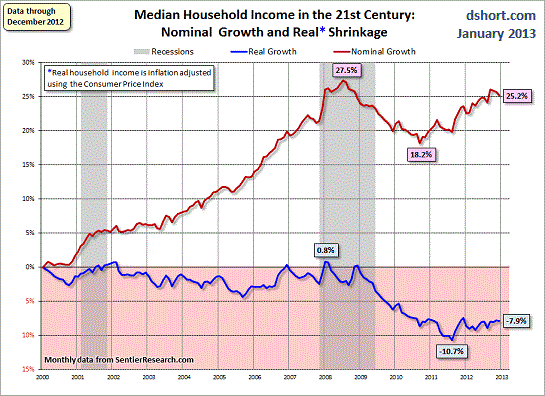The U.S. Has An Even Larger Gap Between The Rich And The Poor Than Downton Abbey Does
There are two very different Americas today. In one, the stock market is soaring, high end homes are selling briskly, big banks and hedge funds are rolling in money as if the last financial crisis never even happened, and life is really, really good. In the other America, good jobs are incredibly scarce, incomes are declining, and poverty is skyrocketing to levels that we have never seen before. The gap between the wealthy and the poor in America is getting wider with each passing day. In fact, it is my contention that the U.S. has an even larger gap between the rich and the poor than Downton Abbey does. If you have never seen Downton Abbey, you really should. It is one of the most extraordinary shows to appear on television in years. It is a drama set in the UK which follows the lives of the aristocratic Crawley family and their servants throughout the early part of the 20th Century. It can be a bit jarring to watch servants wait on their masters hand and foot and refer to them by such titles as “Lord” and “Lady”, but the truth is that in many ways there is more inequality today than there was back then. As far as people living in the worst areas of cities such as Detroit and Cleveland are concerned, the socialites that live on Fifth Avenue in New York City or in multi-million dollar homes out in the Hamptons might as well be from another planet. If you have lots of money, America is still a really great place to live. If you barely have any money, America can be really cold and cruel. Sadly, our politicians continue to pursue policies that make things even better for those working for the establishment in places such as Washington D.C. and Manhattan, and worse for all the rest of us. This has especially been true over the course of the past four years. If nothing is done, the gaping chasm between the rich and the poor will continue to get even worse, and in the end that will have some really severe consequences for our society.
So is the answer to raise taxes and “redistribute” more money to the poor? Of course not. Today, we are already paying dozens of different kinds of taxes every year and the government is handing out more money to people than ever before. But poverty just continues to explode.
What the poor in the U.S. desperately need are good jobs, but we continue to ship millions of good jobs out of the country and Barack Obama continues to pursue policies that are killing the U.S. economy.
There is not much help on the horizon for the poor or the middle class in America, and that should be distressing for all of us.
But things in the wealthy parts of America are going absolutely wonderfully right now. Let’s take a few moments and contrast what life is like in the two Americas right now…
In the “good America”, stocks are absolutely soaring. In fact, the S&P 500 closed above 1,500 on Friday for the very first time in more than five years.
In the “bad America”, poverty statistics just continue to get worse. According to a newly released report, 60 percent of all children in the city of Detroit are living in poverty.
In the “good America”, hedge funds are rolling in the profits. The Dow just had its best January since January of 1994, and many analysts are projecting that 2013 will be a banner year for the markets.
http://theeconomiccollapseblog.com/archives/the-u-s-has-an-even-larger-gap-between-the-rich-and-the-poor-than-downton-abbey-does
Understanding Failed Policies: Wealth Effect, Wage Effect, Poverty Effect
Central banks’ attempts to boost borrowing, consumption and wages by inflating asset bubbles leads to the poverty effect, not the wealth effect.
Central bankers have been counting on “the wealth effect” to lift their economies out of the post-2009 global meltdown slump. The
wealth effect concept is simple: flooding the economy with credit and
zero-interest money boosts the value of assets such as housing, stocks
and bonds. Those owning the assets feel wealthier, and thus more
inclined to borrow and spend more money. This new spending creates more
demand which then leads employers to hire more employees.
Unfortunately for the bottom 90% who don’t own enough stocks to
feel any wealth effect, the central bankers got it wrong: wages don’t
rise as a result of the wealth effect, they rise from an increased
production of goods and services. Despite unprecedented money-printing, zero interest rates and vast credit expansion, real wages have declined.

No comments:
Post a Comment